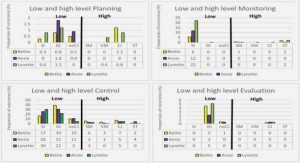Get Complete Project Material File(s) Now! »
Theoretical Background
Introduction to Absorbing Dynamometers
Dynamometers are used widely in many applications. The most common application is in the car industry which uses dynamometer to measure the torque of the combustion engine.In the machining (milling and drilling) process one of the most important variables is the cutting force that is generated by the cutting tool which can be measured with a dynamometer. [1] The dynamometer is useful in biomechanical studies where the grip force of the human hand in various activities is of high importance. [2] What they all have in common and the main purpose of the dynamometer is to translate energy from a source and measure the energy translated through the dynamometer. Through the measurements, the force generated by the source can be calculated and evaluated. In the case of a combustion engine, the force that needs to be measured is in the form of torque. [3] The black box (Figure 1: Black Box of an Absorbing Dynamometer) below shows the inputs and outputs of an absorbing dynamometer. The kinetic energy is the torque from the engine or the force from the cutting tool and grip force. This energy is translated and absorbed by the “absorber”. The absorber could be in the form of springs, electric engine, hydraulic systems and many more.All the energy entering the absorber cannot be absorbed, energy is “leaking” in the form of friction/heat generation. This can be viewed as a margin of error if not taken in consideration when measuring the absorbed energy. To avoid this the force can be measured using load sensors and the torque and power can then be calculated.
Coupling
A crucial question that arises when developing a dynamometer for a product is where to attach the dynamometer to the product i.e. where should the coupling be. There are two extreme points on where to put the coupling. Either it can be attached at the most outmost point where the product delivers its power or it can be attached to the most inner point of the products power. For example a cars most utmost point of power is the wheels and the most inner point of power is the crankshaft. These two different ways of mounting the dynamometer will be called chassis mounted dyno and crankshaft mounted dyno. Where to put the coupling is not the only question that needs answering. How to transfer the power is another big question. There are several ways to connect the dyno and transfer the power, especially in chassis mounted dynamometer. The crankshaft mounted dyno almost always use a simple axis shaft power transfer since it is the most convenient solution, shaft out from engine and shaft in to dyno. With chassis mounted dynamometer the design of the power transfer is highly dependent on how the final power output of the product looks like. When designing and dimensioning the coupling, not only the strength of the coupling is important, vibrations can have a huge impact on the fatigue strength.The natural frequency of the vibrations needs to be avoided.To relive a shaft coupling from the vibrations a part of the shaft can be made of flexible material that can dampen the vibration that would otherwise propagate. In cases where the combustion engine suffers the risk of failure a weaker part can be introduced to the coupling, in that way, if the engine fails and large loads propagate to the dynamometer the coupling/shaft will break before and spare the, often more expensive, dynamometer.
Chassis Mounted Dynamometer
The chassis mounted dyno is used when the performance of the product as a whole is of importance. Any dynamometer that is mounted close to the final power output can be called chassis mounted dynamometer. A chainsaw final power output is on the chain of the chain saw. To understand and measure the cutting force, power torque etc. a chassis mounted dynamometer is needed since there can be a lot of friction and other power “leakage” between the crank shaft and the chain that needs to be taken into account.Cars have a lot of transmissions and couplings from the crankshaft to the output of the wheels, therefore it can be very important to not only measure the power of the engine, but the power of the car itself. The chassis mounted dynamometers for cars are mounted beneath the car and the coupling between the car and the dyno is located on the driven wheels of the car. The dyno coupling is one or two rollers that the frictions of the wheels drive (see Figure 3). The absorber then loads the engine by absorbing the roller torque.
1 Introduction
1.1 BACKGROUND
1.2 ENGINE TESTING AT HUSQVARNA
1.3 PURPOSE AND RESEARCH QUESTIONS
1.4 DELIMITATIONS
1.5 OUTLINE
2 Theoretical Background
2.1 INTRODUCTION TO ABSORBING DYNAMOMETERS
2.2 COUPLING
2.2.1 Chassis Mounted Dynamometer
2.2.2 Crankshaft Mounted Dynamometer
2.3 ENGINE AND DYNAMOMETER CONTROL MODES
2.3.1 Position/speed mode
2.3.2 Position/torque mode
2.4 VIBRATIONS
2.5 METHODS FOR MEASURING TORQUE
2.5.1 Trunnion-Mounted Dynamometers
2.5.2 In-Line Torque Measurement
2.6 DIFFERENT TYPES OF DYNAMOMETERS/BRAKES
2.6.1 Electric Dynamometers
2.6.2 Air Brake
2.6.3 Hydraulic Brakes
2.6.4 Friction Brakes
2.6.5 Hybrid Systems
2.7 ANALYSIS OF ENGINE TEST AND REPORTS
2.8 SPECIFIC REQUIREMENTS
2.8.1 Low moment of inertia
2.8.2 Higher RPM
2.8.3 Down scale of components and measurements
2.9 NORMAL USAGE OF CHAINSAW
3 Method and Findings
3.1 HUSQVARNA’S ENGINE TESTS
3.1.1 Pros and cons
3.2 THE OBJECTIVE
3.3 PLANNING
3.4 REQUIREMENT SPECIFICATION
3.4.1 Major Function Requirements
3.4.2 Major Handling Requirements
3.5 CONCEPT GENERATION AND SELECTION METHOD
3.5.1 PM-motor
3.5.2 Eddy Current Brake
3.5.3 Water Brake
3.5.4 Hydraulic Oil Pump
3.5.5 Morphological Matrix
3.5.6 Weighing and Pugh-matrix
4 Results, Further Development and Analysis
4.1 DESIGN OF COUPLING
4.2 CALCULATIONS
4.2.1 Chainsaw:
4.2.2 Pump:
4.2.3 Strength at Nose sprocket
4.3 THE SERVO PUMP TEST (CONCEPT TEST)
4.3.1 Test Procedures
4.3.2 Results:
4.4 SELECTION OF COMPONENTS FOR PROTOTYPE
4.5 TEST-RIG SETUP
4.6 TEST OF FINAL PROTOTYPE
4.6.1 Test in room temperature
4.6.2 Test in climate chamber at -25 °C
5 Discussion and Conclusion
6 References
7 Figures:
7.1 APPENDIX 1
7.1.1 Requirement Specification




